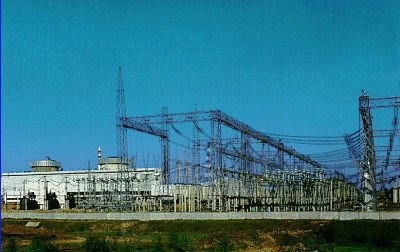
Substation
The substation functions as the interface between the power plant and the electrical grid. The output from the plant's generator(s) is supplied to the substation where the power then often feeds through 3 or more lines at very high voltages - 220,000 volts AC (also called 220KV), 345KV, or higher. Examples of substation equipment are shown in the following photos.
 |
|
| Courtesy Kalinin NPP |
The generator transformer, located either close to the generator or in the substation, steps up (increases) the voltage from about 20,000 volts (20KV) to the higher voltage (220KV or 345KV).
Substations use large circuit breakers which can open to protect the grid or the plant from high voltages, high or low frequencies, or high currents. The arc that occurs when the breaker is opened is quenched by oil, air, or other gas. Substations also use disconnects (bars that can be rotated) to isolate the breakers so that work can be done on the breakers safely. With the high voltages and currents present in the substation, one must work and keep metallic materials a good distance from the powered equipment.
The substation also functions to supply power to the plant for starting up the unit. During normal operation, the substation may supply power to some of the major equipment. The plant itself may supply other major equipment from the generator. Emergency sources are only used for testing or if needed.
Copyright © 1996-2004. Joseph Gonyeau, P.E.. The Virtual Nuclear Tourist. All rights reserved. Revised: March 15, 2001